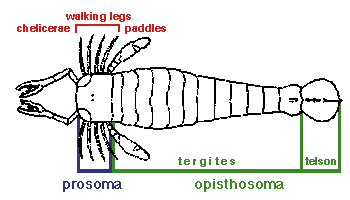







More is known about the external morphology of eurypterids than perhaps any other group of fossils; they are almost as well known as modern animals. The body of eurypterids is segmented, as in all arthropods, and may be divided into two basic parts. The front portion is the prosoma, where the legs are attached and the eyes and mouth are located. The rear portion is the opisthosoma, which may be further divided into a region of twelve tergites (tail segments) and the telson. See the diagram below to help clarify these regions, then compare with the Xiphosura (horseshoe crabs), another group of chelicerates.

The prosoma of eurypterids is both the head and forebody of the animal. The dorsal (top) side of the prosoma is a single plate from which protrude two compound eyes at the sides, and two smaller ocelli (simple eyes) from the top central portion. The eurypterid shown above (Pterygotus) has unusually large compound eyes. The ventral (belly) side of the prosoma may be a single shield-like plate or many small plates. The mouth is underneath in the center, where the legs are attached.
There are six pairs of appendages attached to the prosoma. The first pair are the chelicerae, which are homologous to the fangs of spiders. The chelicerae are not homologous to the pincers of scorpions, despite their resemblance in the diagram above; scorpion pincers are the second appendages, not the first. In most sea scorpions, the chelicerae are rather small; only the Pterygotina have chelicerae as large as those shown above. The next four pairs of appendages are the walking legs. These may have spines, and may come all in a single shape (as above), or may be of several sizes and shapes as in the genus Mixopterus. The final pair of appendages may also be legs in some species, but usually are modified into paddles.
The opisthosoma always has twelve segments called tergites. The first six are usually broader than the last six, and so are given the special name mesosoma, meaning "middle body". The mesosomal tergites are the segments that bear the five pairs of gills, which are covered by protective plates. The first pair of gills/plates also contain the reproductive organs. The remaining six segments form a narrower "tail" that may be flattened or tube-shaped. At the end of the tail is the telson. This final segment may be a spike, a paddle, or a set of pincers.
Far less is known about the internal structure of sea scorpions. There are a few fossils in which part of the intestine is preserved, and this ends in an opening between the final tergite and the telson, on the underside of the tail.
Jason Dunlop of the University of Manchester has reported finding slit-like structures and book lungs on some eurypterid fossils. Such structures are today known only in arachnids.

Paul A. Seldon & Jason A. Dunlop, 1998. "Fossil Taxa and Relationships of Chelicerates" pp. 303-311 in G. D. Edgecombe (ed.) Arthropod Fossils and Phylogeny, Columbia Univ. Press, New York.

